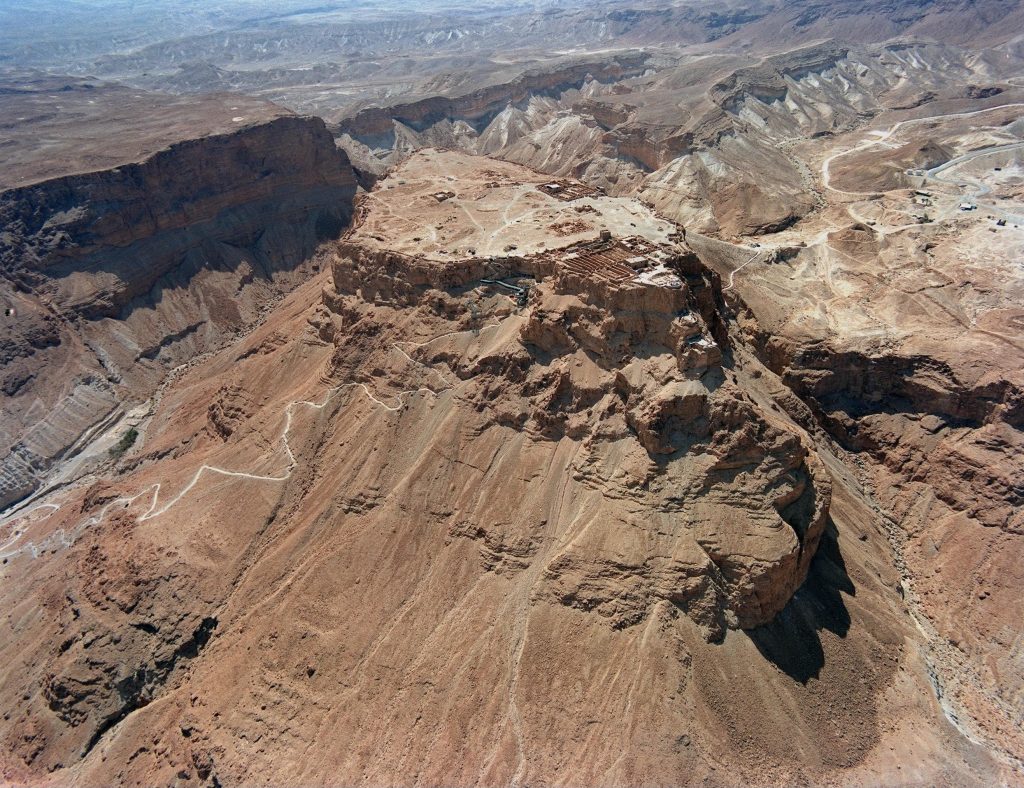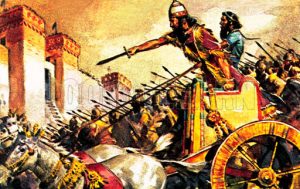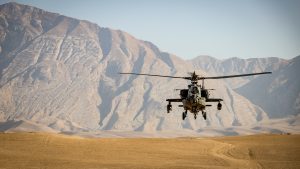Masada was an impressive fortress built upon a plateau to protect Jewish Zealots and refugees from the Romans. The Jews wisely chose this location because of its natural defenses against invaders. They imagined it would be impossible for anyone to besiege the city; the treacherous terrain and great outer wall surrounding Masada surely would protect it. Unfortunately, the Jews underestimated the Roman army.

Masada appeared to be the perfect fortress. Its four vertical sides made it nearly impossible to invade. The largest wall on the eastern side is one hundred forty meters above the desert floor, roughly half the size of the Eiffel Tower. From the east, there is a dangerous zig-zagging trail called the serpent’s path. The western side wall is eighty meters above the desert floor, as tall as the Statue of Liberty. The inhabitants took the extra precaution and built two walls on the perimeter of the plateau about 1400 meters long and six meters tall. The outer wall was 1.4 meters thick and the inner was 1 meter thick. Between the inner and outer wall, there was an empty space. During an invasion they planned to fill the gap with stone, wood, and dirt to strengthen the wall; until then it was used for storage. There were also twenty-meter-tall towers strategically spaced out throughout Masada for defensive reasons.1
The defenders were aware that if one were to attack, the first action the enemy would take would be to stop the water supply. Anticipating that possibility, the defenders built twelve cisterns to hold the water inside the fortress. Along the western slopes they had enough water stored to fill sixteen Olympic pools. It was very forward thinking of the Jews to do this. They also had many food storehouses toward the north. They kept grain, oils, corn, wine, dates, along with other foods. Thanks to the dry climate, storing the food was not a problem. In case they were to run low, the flat land would be ideal to grow additional food. Remains of the wall, tower, cisterns, food storage buildings, and other structures are still visible today.1

Unfortunately, these precautions were no match for the Roman army. In 73 C.E., Flavius Silva marched the Roman army and other troops totaling about 10,000 soldiers south to conquer Masada. Waiting on top of Masada were the 1,000 men (Jewish refugees and Zealots) willing to defend their safe haven. The Romans were aware it would take a significant amount of time to destroy Masada, so they set up camp and had Jewish war prisoners bring a constant supply of food and water. They first stopped up the aqueducts and diverted them for their own use. Next, they constructed a wall around Masada to prevent the inhabitants from escaping, and to cut them off from the outside world, a classic Roman war operation. The wall was three meters high and 3.2 kilometers long, and enforced by eight camps with many other guards posted. This impressive mechanism was built in a matter of days and can still be seen today.1

The Romans knew this would not be a quick victory; they would have to overthrow Masada by force. They came to the conclusion that the only way to reach the top of Masada was by making the steep side into a gradual incline. To do this, they took advantage of a natural spur called the white rock on the western side. It was nearly two hundred meters from the top of Masada to the edge of the natural gulf. The ramp to the top was built at a twenty degree incline. It took months to build the massive ramp. Every day, the inhabitants of Masada would wake up to see the enemy growing closer and closer, with no way for them to escape. As the Romans got close to the top, they became more vulnerable to the defenders. The Jews at the top could now shoot arrows and defend themselves against the Romans. As a result, the Romans had the Jewish war prisoners shield them so that they could shoot back. Within two months, the great ramp was complete. It was two hundred twenty meters long, and archaeologists assume it weighed as much as one and a half empire state buildings.4
The Romans attacked Masada with their siege towers. They rolled the massive towers up the man-made ramp to overthrow Masada. The inhabitants tried to fight back, shooting arrows at the towers and trying to destroy it with fire.4 The day before the final attack, the Romans carefully planned how they would conquer Masada. Early that morning, they charged up the ramp, and over the walls. To their surprise, they were not met with a fight. Instead, they encountered thousands of dead bodies. The few remaining women and children explained to them what had happened. The Jews knew they did not stand a chance against the Roman army of 10,000. They decided it would be better to die than to be conquered. Since Judaism does not allow suicide, they came to the conclusion they would have to kill each other. The men first killed the children and women; then they cast lots to decide who would be killed first, and who would have to be the last to commit suicide. It is ironic how they ignored the sixth commandment not to murder, but decided to alter its meaning to mean not to murder yourself. Despite the confusion, they ultimately chose death over slavery.6
- Encyclopedia Judea, 2007, s.v. “Masada,” by Michael Berenbaum. ↵
- Encyclopedia Judea, 2007, s.v. “Masada,” by Michael Berenbaum. ↵
- Encyclopedia Judea, 2007, s.v. “Masada,” by Michael Berenbaum. ↵
- The Greenhaven Encyclopedia of the Ancient World, 2002, s.v. “Siege of Masada,” by Don Nardo. ↵
- The Greenhaven Encyclopedia of the Ancient World, 2002, s.v. “Siege of Masada,” by Don Nardo. ↵
- Encyclopedia of Death & Human Experiences, 2009, s.v. “Mass Suicide,” by Clifton D. Bryant. ↵



86 comments
Faisal Alqarni
Hi Jennifer, I love your use of images it is very attention catching and brings your story on the fortress of Masada to life. From just looking at the images it looks impossible to even get on top of the plateau but then again the Jews zealots were going against the greatest empire that ever lived and have to say the determination of the Roman and their understanding of war tactics is very impressive indeed. I especially loved the siege towers. The Jewish communities building a fortress with such great thought was no match for the Roman’s but still it showed that even the weak when they come together can really do great things as shown by the fortress that was Masada.
Irene Astran
I found it very helpful that you compared Masada to popular monuments. It helped me gauge just how large this establishment was. I was also impressed with the comparison you made in regards to their cisterns. I cannot believe that they were able to store 16 Olympic swimming pools worth of water. They seem to have really covered their bases, almost as if they could foresee this event.
Elizabeth Garibay
I love the fact that before reading this I had no prior knowledge on this article topic, but as I was reading I felt like it was easy to understand. Although it was a great story, It was sad how the Roman army went so far as to killing one another. Besides that, you did a good job of describing everything. I look forward to reading more articles like this! Thank you for writing!
Zaraly Frasquillo
Great job Jennifer! I just learned about the Zealots but I did not know about their amazing fortress, Masada. It is really sad to hear that although this amazing fortress could have protected them it did not. I honestly hate the Romans, they were so mean, but that does not matter now. You made this article into a great story, and i love it! I think you wrote an amazing article and I am so excited to read any other of your work.
Cameron Mays
Even the topics that are never talked about, I still knew something about them, however, I have never heard anything about this, so that was a good way to get people to click on it. It was also quite well researched. Furthermore, it was organized quite well and kept me reading the whole time. I felt like your sentence structure and word choice were on top of their game as well. All of this together made quite a great read and I enjoyed it. You enticed me especially with your first paragraph.
Sergio Cervantes
Well I must say you captured my attention with the last paragraph. One would never assume the Jews would commit suicide, but yet, they did. It surprises me that they killed each other off until most of the populace was dead. I find it interesting how the Romans conquered Masada. The tactics they used by employing Jewish prisoners of war as human shields as they built their ramp and constructing a large wall to prevent anyone from escaping. Great article Jennifer!
Gabriela Medrano
It is truly amazing to see the intriguing and dynamic structures the Romans built in such a small amount of time. I had never heard of the Masada fortress and I think it is so cool that it was built on a plateau. The Jews seem to never have the right in anything and are always under someone’s radar and it was very unfortunate the resort they had to come to because of the all mighty Romans. Let us be realistic their decision was probably not the best but then again the Romans are not friendly enemies. Anyway, great article and interesting topic!
Mario Sosa
I was amazed at how anyone would choose a plateau as tall as the statue of liberty to live on. The twist at the end was very interesting. After months of careful planning and preparation, the Romans finally reached the top of this fortress only to see that most of the people had killed each other. I took joy in reading your article, great job!
Bailey Rider
This is such an interesting article! It’s amazing how they build such an impressive fortress and even thought ahead with food and water to prepare for a siege! It’s amazing that they built such huge walls around Masada. Because it was so impressive, it’s mind blowing that the Romans figured out how to get pass their walls and protections. It’s extremely sad but courageous that the Jews chose death over slavery though. Great, well written article!
Alyssa Vela
I liked that I had no prior knowledge on this article topic, but as I was reading I felt as though it was really easy to comprehend. It was so sad how the Roman army drove them as far as to kill one another(and themselves) to avoid being enslaved. Overall your descriptions were very well written, and easy to read. I look forward to reading more informative articles like this! Thank you for writing!